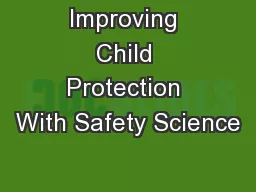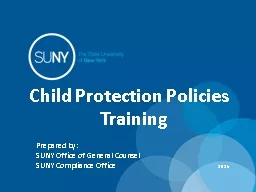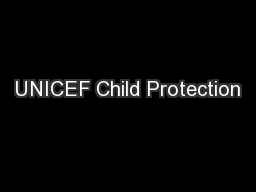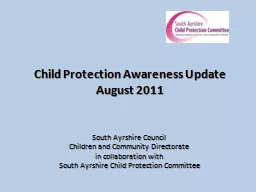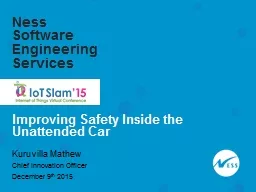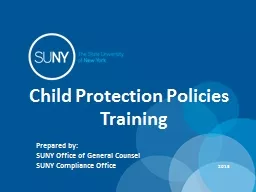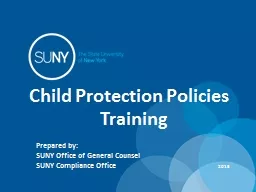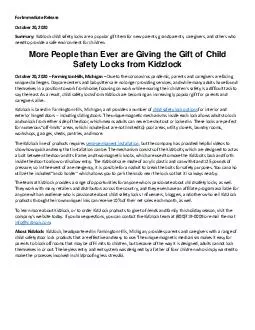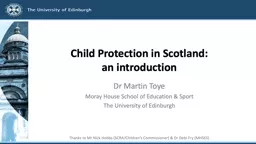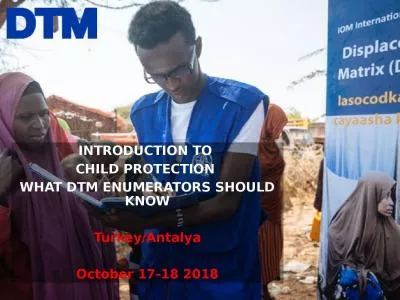PPT-Improving Child Protection With Safety Science
Author : olivia-moreira | Published Date : 2017-04-06
Michael Cull PhD Deputy Commissioner Child Health Tennessee Dept of Childrens Services 1 My plan Describe S afety Science Safety Culture and High Reliability
Presentation Embed Code
Download Presentation
Download Presentation The PPT/PDF document "Improving Child Protection With Safety S..." is the property of its rightful owner. Permission is granted to download and print the materials on this website for personal, non-commercial use only, and to display it on your personal computer provided you do not modify the materials and that you retain all copyright notices contained in the materials. By downloading content from our website, you accept the terms of this agreement.
Improving Child Protection With Safety Science: Transcript
Michael Cull PhD Deputy Commissioner Child Health Tennessee Dept of Childrens Services 1 My plan Describe S afety Science Safety Culture and High Reliability Organizations Explain how principles of HRO can be applied to support a Traumainformed Resilient Child Welfare system. Kenneth Burns. 24. th. January 2011, University of Sussex. 4.4 million people. Celtic Tiger . economic growth. Economic crisis of 2008. Cutbacks in health and social services began in 2006. €30-€35 Billion cutbacks in state spending. A Centrally Sponsored Scheme of Indian Government – Civil Society Partnership. By Malay Dewanji, . Hony. General Secretary, LAMP, India.. And President, FICE – India.. India is home to almost 19% of the world’s children. More than one third of the country’s population, around 440 million, is below 18 years. India’s children are India’s future as strength of the nation lies in a healthy, protected, educated and well-developed child population that will grow up to be productive citizens of the country. India must invest resources in children proportionate to their huge numbers. . Training. Prepared by:. SUNY Office of General Counsel. SUNY Compliance Office . 2015. Child Protection Policies Training. Prepared by:. SUNY Office of General Counsel. SUNY Compliance Office . International . Initiatives Aimed . at Supporting National and Local Level Violence Prevention . Theresa, . Child . Section . NYHQ. Theresa . Kilbane. Senior Child Protection Advisor. United Nations Children’s Fund, NYHQ. South Ayrshire Council. Children and Community Directorate . in collaboration with . South Ayrshire Child Protection Committee. Child protection: . awareness and information. PROTECTION OF CHILDREN. We all have a responsibility to make sure that children . Child Online Protection . in . Iran. Activities and Suggestions. Viewpoint and Approaches. Broad definition of Child Online Protection Includes. Crimes against the children like child pornography. the Unattended Car . Ness. Software Engineering Services. Kuruvilla Mathew. Chief Innovation Officer. December 9. th. 2015. What is this session about?. Applying IoT to improving safety inside an unattended car (or vehicle) when there are restrained unattended occupants on a hot summer day.. Training. Prepared by:. SUNY Office of General Counsel. SUNY Compliance Office . 2015. Child Protection Policies Training. Prepared by:. SUNY Office of General Counsel. SUNY Compliance Office . Training. Prepared by:. SUNY Office of General Counsel. SUNY Compliance Office . 2015. Child Protection . Policies Training. Prepared by:. SUNY Office of General Counsel. SUNY Compliance Office . Kidzlock child safety locks are a popular gift item for new parents, grandparents, caregivers, and others who need to provide a safe environment for children. Visit: https://www.kidzlock.com/ an introduction. Dr Martin Toye. Moray House School of Education & Sport. The University of Edinburgh. Thanks to Mr Nick Hobbs (SCRA/Children’s Commissioner) & Dr Debi Fry (MHSES). ‘All about me…’. IPV is a vaccine given with the third dose of Oral Polio Vaccine (OPV), when your IPV plus OPV provides your child with the best protection from polio. Can I delay the IPV or any of the scheduled vac Child Protection & Safeguarding: A Framework for . Practice. Francis . Rebello. Consultant. , Child Protection- HCL Foundation . TASK FLOW. Child Protection . Policy. - Content- A Gist. ABOUT HCL FOUNDATION. WHAT DTM ENUMERATORS SHOULD KNOW. Turkey/Antalya. October 17-18 2018. Part 1. Introduction to Child Protection . CHILD PROTECTION AND DTM. Learning objectives . Work together using a common definition of “child”..
Download Document
Here is the link to download the presentation.
"Improving Child Protection With Safety Science"The content belongs to its owner. You may download and print it for personal use, without modification, and keep all copyright notices. By downloading, you agree to these terms.
Related Documents

